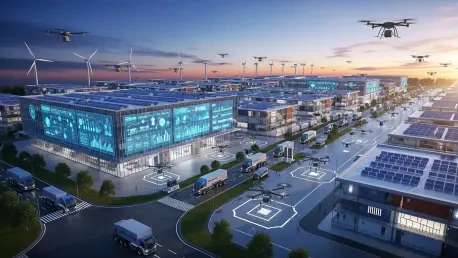The Rise of E-Logistics in Uzbekistan’s Trade Landscape
Imagine a landlocked nation in the heart of Central Asia, surrounded by vast distances from global ports, yet managing to carve a path to international markets through digital innovation. Uzbekistan, with its unique geographical challenges, is witnessing a remarkable surge in e-logistics and e-commerce, positioning itself as a burgeoning player in global trade. The adoption of digital tools is no longer a luxury but a necessity for a country striving to overcome physical barriers, with e-logistics becoming a lifeline for connecting local businesses to the world.
This digital transformation spans critical segments such as digital freight management, customs digitization, and supply chain optimization, each playing a pivotal role in streamlining trade processes. Technologies like AI-powered systems for predictive analytics, smart warehouses for inventory efficiency, and automated sorting for rapid processing are at the forefront of this revolution. These advancements are reducing delays and enhancing the traceability of goods, making trade operations more seamless than ever before.
Key market players, including government-backed platforms and private logistics firms, are driving this shift with innovative solutions tailored to Uzbekistan’s needs. The significance of e-logistics extends beyond mere convenience; it serves as a bridge to integrate Uzbekistan into global supply chains, mitigating the limitations of its landlocked status. By leveraging digital platforms, the country is not just keeping pace but setting ambitious goals to redefine its role in international commerce.
Key Trends and Growth in Uzbekistan’s E-Logistics Sector
Emerging Trends and Technological Innovations
The e-logistics sector in Uzbekistan is being shaped by transformative trends, with digital platforms for route tracking and tariff comparisons gaining traction among exporters and logistics providers. These tools allow businesses to optimize transportation paths and costs, ensuring competitiveness in a complex market. Additionally, blockchain technology is emerging as a game-changer, promising enhanced transparency in transactions and documentation across supply chains.
Consumer behavior is also evolving, with a growing reliance on e-commerce fueling demand for faster and more reliable delivery systems. This shift is pushing logistics companies to adopt innovative solutions to meet expectations for speed and efficiency. Government support, coupled with geopolitical imperatives to diversify trade routes, acts as a catalyst, while small businesses and exporters find new opportunities to expand their reach through accessible digital tools.
Market Performance and Future Projections
Recent data highlights the tangible impact of e-logistics on Uzbekistan’s trade efficiency, with customs clearance times dramatically reduced to 20 minutes for exports and 3 hours for imports. Foreign trade volume has seen an impressive eightfold increase over recent years, and customs revenues have soared to 63 trillion soums, reflecting robust growth. These achievements underscore the effectiveness of digital interventions in modernizing trade processes.
Looking ahead, projections suggest that e-logistics will continue to elevate trade efficiency and market access by 2030, driven by current strategies and alignment with global digital trends. With sustained investments in technology and infrastructure, Uzbekistan is poised to further reduce operational bottlenecks, potentially becoming a benchmark for digital trade facilitation in the region.
Challenges in Implementing E-Logistics in Uzbekistan
Uzbekistan’s landlocked geography presents persistent logistical hurdles, with high transport costs posing a significant barrier to competitive trade. Geopolitical tensions in surrounding regions could exacerbate these costs by up to 30%, straining exporters and necessitating adaptive strategies. The reliance on transit through neighboring countries further complicates the logistics landscape, demanding innovative approaches to maintain cost-effectiveness.
Technological challenges also loom large, as widespread digital adoption requires substantial infrastructure readiness and investment. Many businesses, especially smaller ones, face difficulties in transitioning to fully digital systems due to limited resources or expertise. Addressing this gap calls for targeted training programs and public-private partnerships to build capacity and ensure inclusivity in the digital shift.
Regulatory complexities add another layer of difficulty, particularly in integrating e-payment systems and automated data exchanges with government frameworks. Overcoming initial barriers requires streamlined policies and international cooperation to establish safer trade corridors. Increased investment in digital literacy and diversified export routes could provide sustainable solutions to these multifaceted challenges.
Regulatory Framework Supporting E-Logistics and E-Commerce
The legal landscape in Uzbekistan is evolving to support the digital trade ecosystem, with the introduction of a new “Electronic Commerce” law marking a significant milestone. Additionally, Resolution No. 885, enforced in late 2024, mandates registration and compliance for e-commerce operators, ensuring accountability through dedicated bank accounts and adherence to tax and advertising regulations. These measures aim to create a structured environment for digital transactions.
Government policies, such as Presidential Decree No. PQ-3832 from 2018, have laid the groundwork for a digital economy by promoting areas like crypto-assets and ICT training. Such initiatives reflect a commitment to fostering innovation while building a skilled workforce capable of navigating digital platforms. The focus on compliance and transparency is evident in the integration of automated systems for data exchange, which bolster trust among stakeholders.
Security measures for digital platforms are also being prioritized to safeguard transactions and user data, a critical factor in encouraging adoption of e-logistics systems. By aligning legal frameworks with technological advancements, Uzbekistan is cultivating an ecosystem where businesses can operate confidently. This regulatory support is pivotal in sustaining the momentum of digital trade and ensuring long-term stability.
The Future of E-Logistics in Uzbekistan’s Trade Ecosystem
Emerging technologies like AI and blockchain hold immense potential to further streamline logistics and customs processes in Uzbekistan, offering solutions for predictive demand planning and secure documentation. These tools could redefine efficiency standards, reducing costs and enhancing reliability across the supply chain. As global digital adoption accelerates, staying ahead of the curve with such innovations will be crucial for maintaining a competitive edge.
Geopolitical shifts and rapid advancements in digital tools present both opportunities and disruptions for the market, potentially reshaping trade dynamics overnight. Consumer preferences are also tilting toward faster, more transparent delivery systems, pushing e-commerce growth and demanding agility from logistics providers. Adapting to these changes will require continuous investment in flexible, scalable systems that can respond to evolving needs.
Uzbekistan’s ambition to become a regional logistics hub is supported by strategic projects like the China–Kyrgyzstan–Uzbekistan railway and the National Strategy for Transport and Logistics Development spanning from 2025 to 2030. These initiatives, combined with factors like global economic conditions and innovation in digital corridors, signal a promising trajectory. Sustained government commitment will be key to unlocking growth areas and solidifying Uzbekistan’s position in the international trade arena.
Conclusion: Uzbekistan’s Path to Trade Transformation
Looking back, Uzbekistan’s journey through e-logistics demonstrates a remarkable ability to reshape its trade capabilities, turning geographical constraints into opportunities for economic growth. The synergy of government initiatives, cutting-edge technological advancements, and strategic international partnerships has laid a strong foundation for this transformation. Each step taken reflects a deliberate effort to integrate into global markets despite inherent challenges.
Moving forward, actionable steps such as sustained investment in human capital through specialized training in digital tools should be prioritized to maintain this progress. Enhancing infrastructure with a focus on smart logistics hubs could further alleviate bottlenecks, while expanding digital platforms will ensure broader access for businesses of all sizes. These measures promise to strengthen Uzbekistan’s standing as a model for other landlocked nations.
Finally, fostering deeper collaboration with global partners to develop secure, efficient trade corridors stands as a critical consideration for the future. By continuing to innovate and adapt to emerging trends, Uzbekistan positions itself not just as a participant but as a competitive force in the global trade landscape. This proactive approach could inspire similar transformations across the region, setting a precedent for economic resilience through digitalization.









